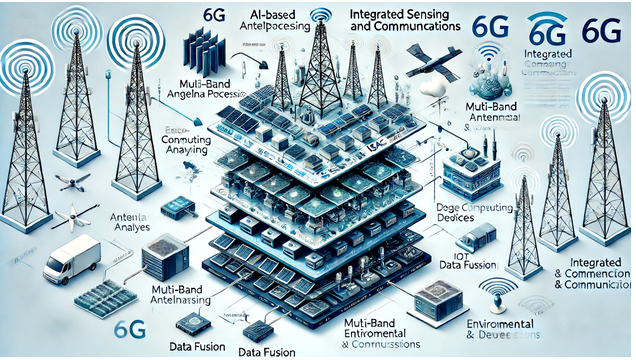6G and 6th Sense : Network as Sensor in 6G
- Daniel Ezekiel
- Mar 25
- 4 min read
Updated: Jun 15

Introduction
With digitization and disaggregated solutions reshaping all sectors, modern network topology now features a Client/End Device layer (often IoT), intermediary Edge devices, and the Cloud/DC, linked primarily by wireless (cellular) technologies.
Traditionally, Mobile/Client/Edge platforms have focused on Connectivity, Compute, Visuals (Graphics, Display, Imaging, Video), AI Inferencing, and Multimodal Sensing. The push for 6G is driven by growing demands for spectrum, reduced interference, faster mobility, and an increase in autonomous, connected devices across sectors like healthcare, security, and robotics.
In 6G, the radio spectrum extends human sensory reach beyond visual and auditory, harnessing the full EM spectrum. With advanced transceivers and AI, RAN can interpret 'received' signals similar to radar, as many radar bands are adjacent to communications bands.
3GPP is setting the stage for Network as a Sensor (NaaS) with frameworks in Release 18 (5G-Advanced) and beyond, establishing protocols and architectures to enable real-time environmental and contextual data sensing across applications. 5G's focus has been on eMBB, URLLC, and mMTC, 6G brings sensing as an additional vector.
AI’s integration into RAN also redefines chipset architectures, enabling RF transceivers and Digital Baseband to support advanced sensing capabilities for the evolving network.
Key Areas in 3GPP’s NaaS Enablement
Integrated Sensing and Communication (ISAC):
- 3GPP is defining ISAC protocols to allow communication signals to serve dual roles in both data transmission and environmental sensing, with added "Sensing Bursts" on the Air Interface.
- ISAC enables 6G networks to use time, frequency, and spatial resources for sensing without impacting communication quality, supporting object detection, movement tracking, and environmental monitoring.
- Higher frequencies enhance sensing precision and capability. However, bring in add on complexities of additional power consumption.
High-Frequency Spectrum Usage (e.g., mmWave and THz Bands):
- The use of mmWave and Terahertz (THz) bands) ‘eventually’ is crucial for high-resolution sensing.
- These high frequencies are also necessary for applications that require extreme bandwidth, like real-time video analytics and autonomous driving, where precise environmental awareness is key.
- While the higher frequencies are good for precision, spatial resolution, detailed environmental sensing, object detection and greater bandwidth provision, this also comes with challenges of greater power consumption in the A2D chains.
Massive MIMO and Beam Forming Enhancements:
- Massive MIMO with advanced beam forming techniques, defined under 3GPP standards, enhances both communication and sensing capabilities.
- Through intelligent beam steering, massive MIMO allows accurate tracking and detection of objects and people, which is useful in urban settings and smart infrastructure applications.
Full Duplex Communications
- Full Duplex communications enable additional precision and accuracy for sensing
- However, these bring in additional challenges in antennas, and self interference cancellation
Standardized AI/ML Integration for Sensing:
- 3GPP for 6G, incorporates AI/ML models directly into the network to process sensing data, optimize resources, and improve sensing accuracy.
- For example, AI/ML can dynamically adapt network parameters to optimize sensing tasks, detect anomalies, and enhance data fusion from multiple sources (e.g., combining radar and LiDAR with network-based sensing).
Resource Allocation and Coordination for Sensing Tasks:
- 3GPP defines mechanisms to manage and allocate network resources (e.g., spectrum, power, and antenna resources) effectively between communication and sensing tasks.
- By coordinating these resources, the network can achieve optimal performance across both communication and sensing functions, essential for data-heavy applications in NaaS.
Multi-Access Edge Computing (MEC) and Edge AI:
- 3GPP’s MEC standards provide a framework for distributing AI processing closer to the source, which is critical for NaaS. MEC allows the network to process environmental data locally, ensuring low latency and real-time decision-making.
- This enables applications like autonomous driving, where fast response times to sensed environmental data are essential.
Opportunities for AI Integration in NaaS
- Real-Time Sensing and Contextual Awareness: AI-driven sensing for immediate context understanding in smart cities, disaster response, drones, and industrial automation.
- Resource Optimization: AI helps dynamically manage and allocate resources in the network to balance communication and sensing, maximizing spectral efficiency.
- Predictive Analysis and Decision-Making: NaaS enabled with AI can foresee environmental patterns, helping in sectors like transportation, healthcare, and retail.
Semiconductor Hardware
Integration of AI for 6G, across different layers of the Protocol Stack (refer to my earlier article) provides the scope for redefinition of the traditional RF-Transceiver and L1 HW, and functionalities.
The earliest expected Chipsets for 6G are roughly around 2028, and mature Chipsets HW/SW around the end of the decade. Based on the use-cases, form factors and product segments that are enabled by 6G, the earliest form factors are expected to be modules that would enable a host of product segments.
The below table provides a quick insight to the firms that are working on 6G, and highlights those that have Sensing as a focus topic currently.

By establishing standards and technologies that integrate sensing capabilities directly within the network, 3GPP is positioning 6G as an intelligent, data-responsive framework capable of capturing real-time insights and enhancing applications far beyond traditional communications, and in tune with the increasing number of use cases across diverse product segments.



